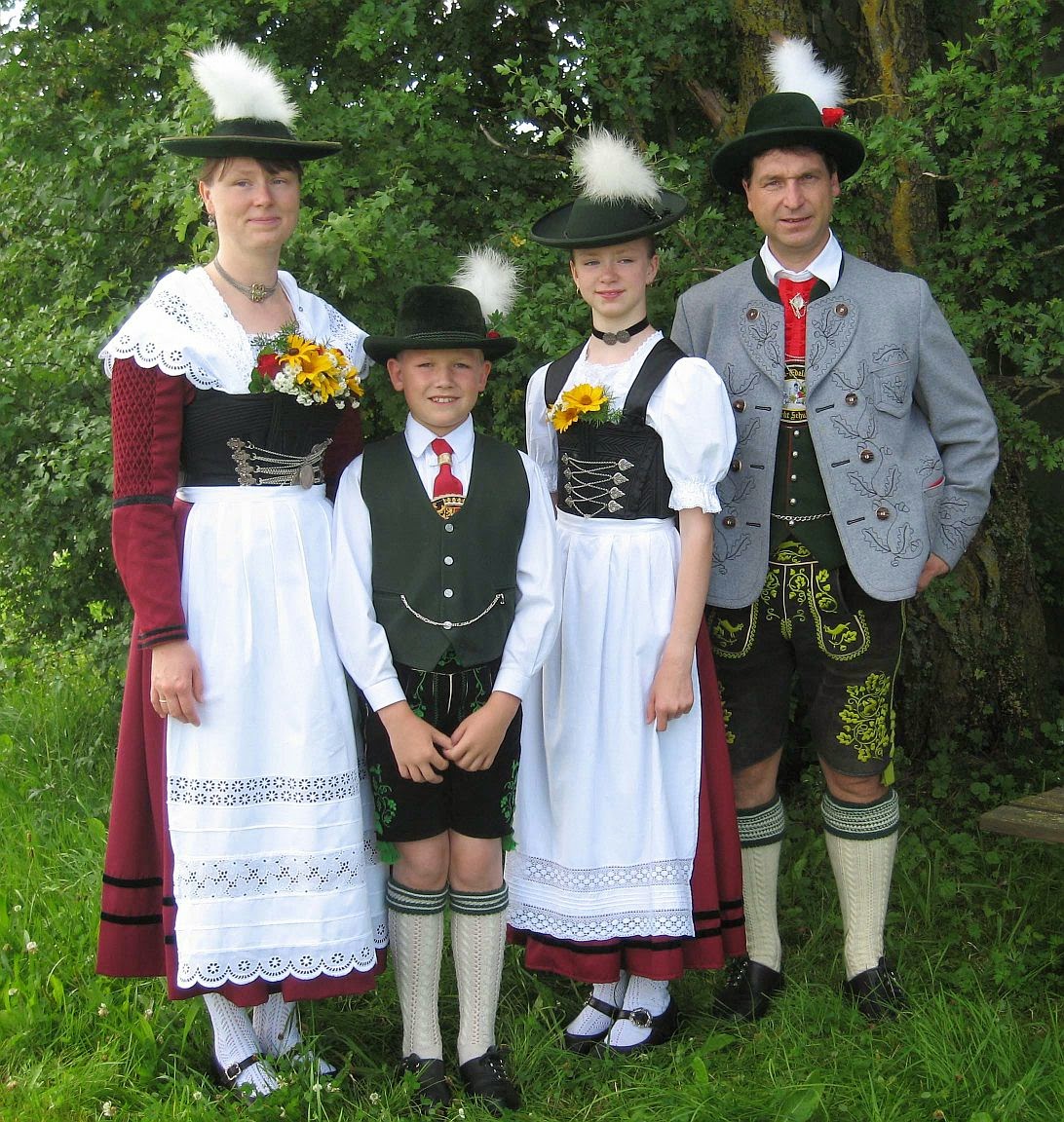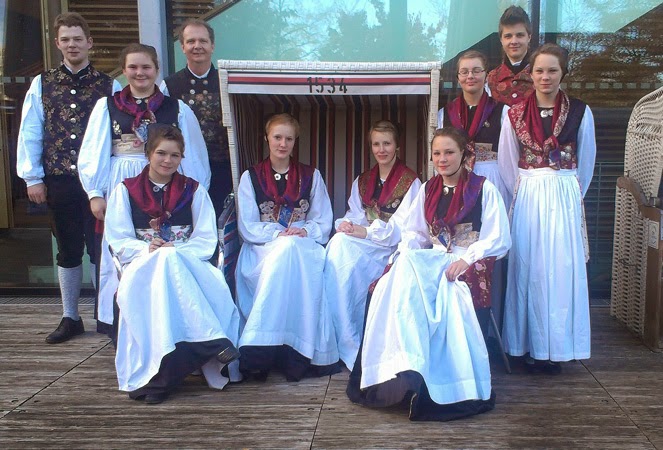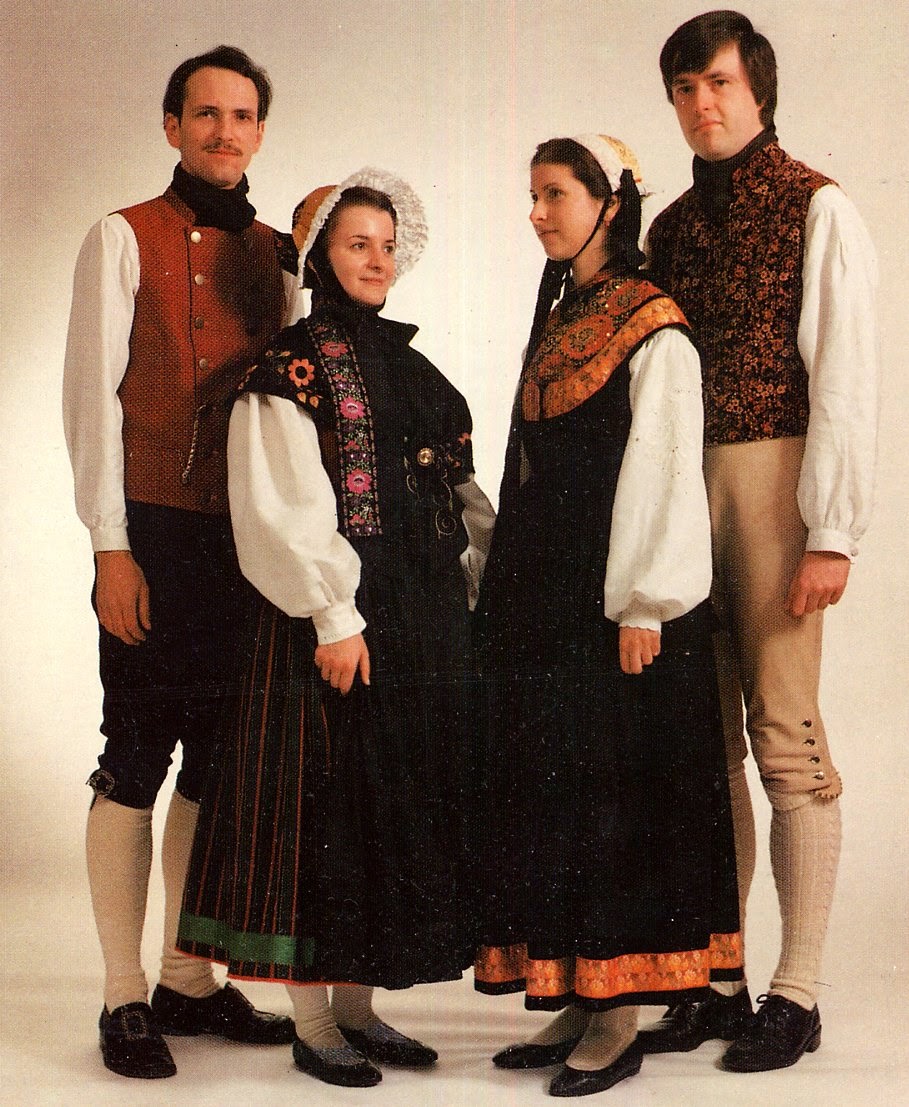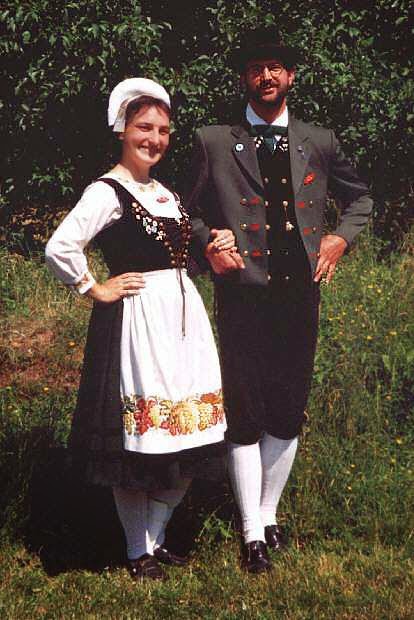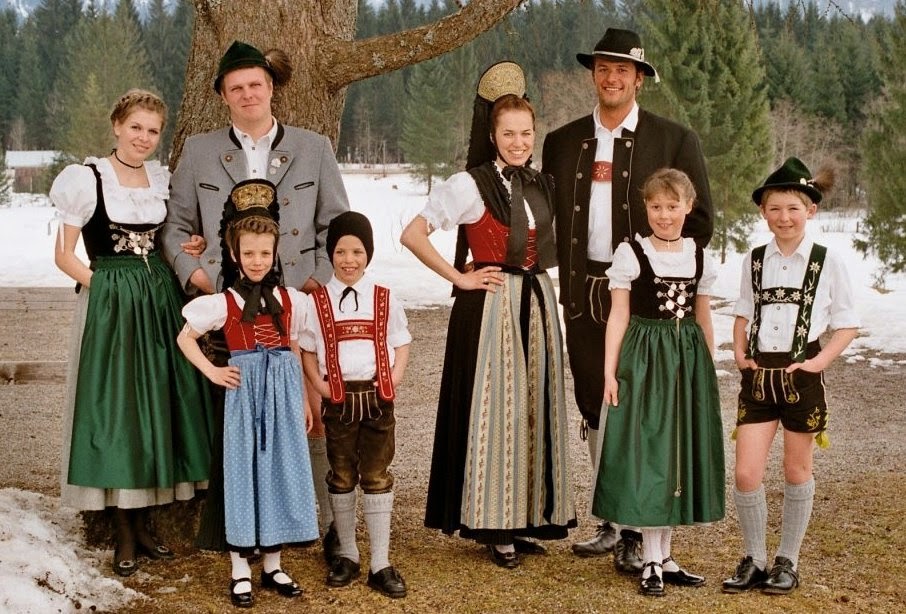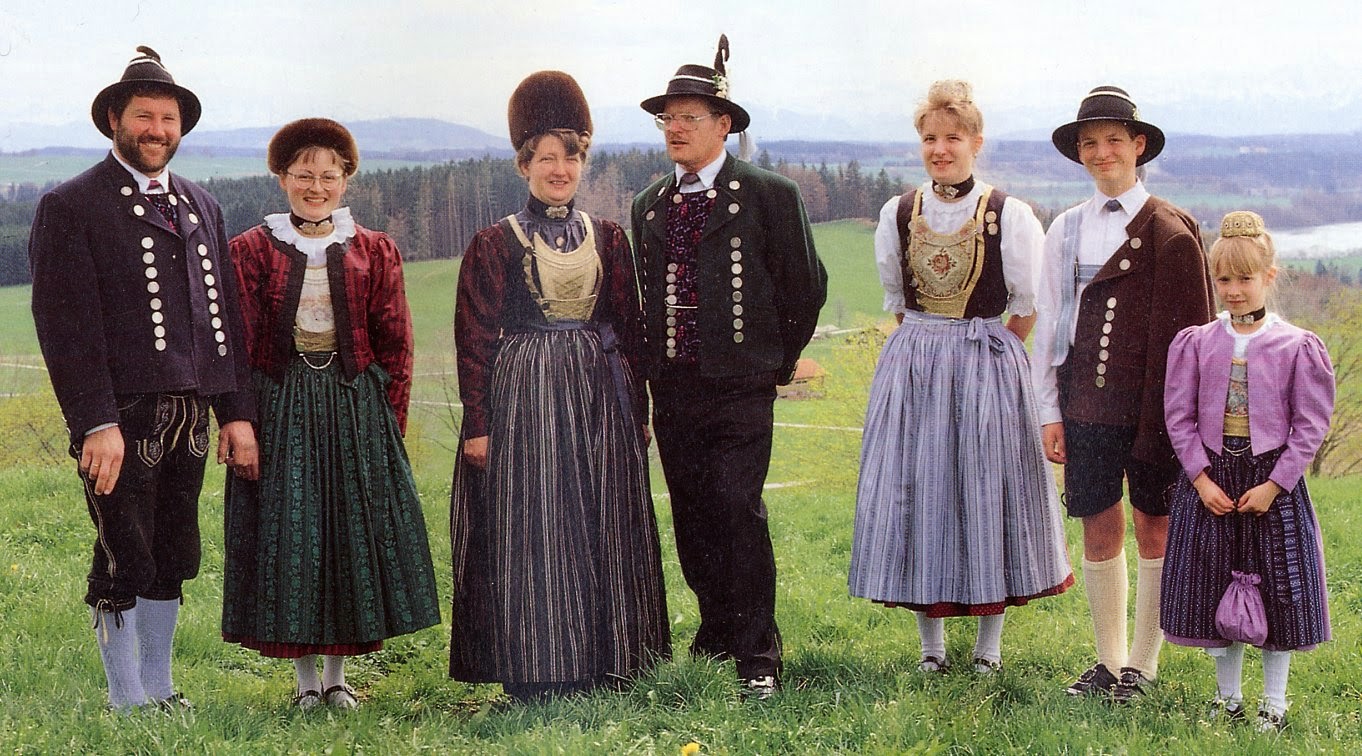Hello all,
Today I will attempt to give an overview of the Folk Costumes of Germany. As in many parts of Western Europe, the survival of Folk costume in Germany is very spotty. The image above is the costume of Miesbach in Upper Bavaria, which is what usually comes to mind when one thinks of Germany. There are a great variety of other costumes. I will try to show one costume from each of the Regierungs Bezirke, the mid level administrative districts of Germany. This will give a broad survey of the nation. Here is a map of the States, followed by a map of the Regierungs Bezirken.
I will proceed roughly north to south. I will also omit the costumes of ethnic minorities, such as the Frisians and the Sorbs.You will note that dirndls will not be in evidence. Dirndls developed in the 20th century from traditional everyday attire, and while they are a folk costume, they are not regional. Some of them are very beautiful, some practical, and others very tacky and schlocky, or downright slutty. There is a place for them, but I will show here the traditional more dressy attire. Also note that this is far from exhaustive, some regions have many more costumes.
Schleswig-Holstein
http://en.wikipedia.org/wiki/Schleswig-Holstein
This State is not subdivided into districts, but historically, the north part is Schleswig, and the south is Holstein, the traditional border being the Eider River. Most of the population speaks German today, but many of the people of Schleswig are of Danish or Frisian origin, and many in the east of Holstein are of Slavic [Wendish] origin.
Schleswig
This photo shows a variety of the costumes of Schleswig.
Holstein
This group is from Probstei, by Shoenberg.
Hamburg
http://en.wikipedia.org/wiki/Hamburg
The city of Hamburg is geographically within Holstein, but has the status of a State within Germany. There is a very well maintained folk costume in the district of the Vierlande, which lies within its borders.
Mecklenburg-Vorpommern
http://en.wikipedia.org/wiki/Mecklenburg-Vorpommern
This State is also not divided into districts, but is historically made up of Mecklenburg, which comprises the western two thirds of the State, and Vorpommern, or Cispomerania, which lies in the east.Mecklenburg
Vorpommern
This is the costume of Moenchgut, on the island of Ruegen.
Brandenburg
http://en.wikipedia.org/wiki/Brandenburg
The population of this state are a mix of Germans, this being the heart of the Germanic Prussian Empire, and Slavs [Wends], who have mixed in this region since the 10th cent.
Most of the Folk costumes which are seen in this region are Sorbian. This costume is from the village of Dennewitz and is known as the Flaeming tracht.
Berlin
Berlin is completely surrounded by the State of Brandenburg. I do not believe that the city has any folk costume tradition.
Obersachsen, Sachsen
http://en.wikipedia.org/wiki/Saxony
This translates as Saxony, or Upper Saxony, and is found in the southeast corner of the present borders of Germany. Many of the folk costumes of this State are Sorbian. Here is an Upper Saxon costume from around Dresden.
Sachsen-Anhalt
http://en.wikipedia.org/wiki/Saxony-Anhalt
This translates as Saxony-Anhalt, and lies between the states of Saxony [Upper Saxony], and Lower Saxony.
This group is from the Harz.This group is from Salzwedel in the north.
Niedersachsen
http://en.wikipedia.org/wiki/Lower_Saxony
Lower Saxony, this lies in the northwest corner of Germany. It is today divided into four Bezirke, Lueneburg, Hanover, Braunschweig, and Weser-Ems.
Lüneburg
Here is one extremely well maintained costume of this area, from Scheessel.
Hanover
One of the most famous and spectacular costumes of this area is that of Buekeburg in Schaumburg.
Braunschweig
Weser-Ems
This costume is from the town of Lingen in Emsland.
Bremen
http://en.wikipedia.org/wiki/Bremen
The famous city of Bremen forms its own City-State in two non contiguous districts, Bremen and Bremen-Port.
Thüringen
http://en.wikipedia.org/wiki/Thuringia
Thuringia, This borders all three Saxonys on the south, with Hesse in the west, and Bavaria in the south.It
Hesse
http://en.wikipedia.org/wiki/Hesse
This is the home of the Hessians. It lies in central Germany The three Bezirke divide Hesse into northern, central and southern regions.
North Hesse
This costume is from the Schwalm, which is the location of the famous German Fairy Tale Rotkäppchen, which literally means 'Little Red Cap', which you can see in the photo. For some strange reason, this is usually translated into English as 'Little Red Riding Hood'. In fact, she did not wear a hood, but a little red cap like this.
Central Hesse
This costume is from Marburg.
South Hesse
This couple is from Odenwald.
Nordrhein-Westfalen
http://en.wikipedia.org/wiki/North_Rhine-Westphalia
This state combines the historic region of Westphalia in the north with the northern part of the Rhineland in the south.
Westphalia
This costume is from near Münster
Nordrhein
This is the most populous part of Germany, and there is little that is remembered of Folk Costume.This group is from Elsdorf.
Rheinland-Pfalz
http://en.wikipedia.org/wiki/Rhineland-PalatinateThis is often translated as Rhineland-Palatinate. This northern part of this State consists of the southern part of the Rhineland. The southern part consists of the Pfaltz found along the Rhine which was formerly a non-contiguous part of the Kingdom of Bavaria.. It is found in central Western Germany, along the French border.
Rheinland
This costume is from Winningen on the Mosel.
Pfaltz
This costume is from Hassloch.
Saarland
http://en.wikipedia.org/wiki/Saarland
This lies in the corner of Germany that borders Lorraine. This group is from the town of Homburg.
Baden-Württemberg
http://en.wikipedia.org/wiki/Baden-W%C3%BCrttemberg
This lies in the southwest corner of Germany and consists of the historic regions of Baden and Wuerttemberg, or Schwabia.Baden is a relatively narrow region on the west of this area, and Wuerttemberg comprises the eastern two thirds.
Lower Baden
This costume is from the area known as Hanauerland. The similarities to the costume of the neighboring region of Alsace are obvious.
Upper Baden
This group is from the village of Furtwangen in the Black Forest.
North or LowerWürttemberg
This is the Betzingen costume.
South or Upper Württemberg
This costume is from the region of WestAllgäu, near the Bodensee. It has much in common with Austrian and Swiss costumes just over the border, including the famous radhaube [wheel headdress].
Bayern
http://en.wikipedia.org/wiki/Bavaria
Bavaria, in the south of Germany, the largest State. It consists of Upper Bavaria, Lower Bavaria, The eastern part of Schwabia, and Franconia.
Schwaben
This costume is from Oberstdorf in Bavarian Swabia.
Mittelfranken
This costume is from Schwabach.
Unterfranken
This costume is from Ochsenfurt in Lower Franconia.
Oberfranken
This costume is from Effeltrich in Upper Franconia.
Oberpfaltz
Sometimes translated as The Upper Palatinate, this is in the east of the State of Bavaria between Bavaria proper and Franconia.This costume is from Parsberg.
Niederbayern
This costume is from the Vils valley in Lower Bavaria.
Oberbayern
Upper Bavaria, the region which is best known for the Miesbach costume, which I featured at the head of the article. Here is a lesser-known costume from the Lech-Ammersee area.
This concludes this article. There are, of course, many more costumes within Germany, both German and non-German. There are also many German costumes from outside Germany, as there are or were many German colonies scattered as far east as the Volga.
I hope that you have found this interesting and informative.
Roman K.
rkozakand@aol.com
Source material:
Much of this is from the websites of various local groups in Germany.
Sieglinde Plank, 'Trachten in Mittelfranken', Schwabach, 1983
Toni Demmelmeier et al, 'Trachten in Bayern vol 1 Miesbach', Munich, 1981
Reinhard Worschech, 'Trachten in Bayern vol 2 Unterfranken', Wuerzburg, 1982
Stefan Hirsch et al, 'Trachten in Bayern vol 5 Lech Ammersee', Munich, 1995
Waltraut Werner-Kuenzig, 'Schwaltzwaelder Trachten', Karlsruhe, 1981
Christiane Gaedtgens, 'Norddeutsche Stickmuster aus Vierlanden, Rosenheim, 1986
D. W. Pettigrew, 'Peasant Costume of the Black Forest', London, 1937
Uwe Karsten, 'Deutsche Trachten', Vienna, 1980
Christian Nieske, 'Trachten in Mecklenburg', Husum, 1991
Debionne/Meissner, 'Die Schoensten Deutschen Trachten', Munich, 1987
Maria Reiners, 'Unsere Tracht', Potsdam, 1930's?
Albert Kretschmer, 'Das Grosse Buch der Volkstrachten', Eltville am Rhein, reprinted 1977
Haus Neuerburg, 'Deutsche Volkstrachten -Eine Sammlung Deutscher Trachtenbilder', Koeln am Rhein, 1938
Friederike Kaesting et al, 'Rote Roeke', Hannover, 2000
Brunhilde Miehe, 'Der Tracht Treu Geblieben bd 4', Bad Hersfeld, 2005
Josef Dunninger, 'Deutsche Volkstrachten', Berlin, 1911
